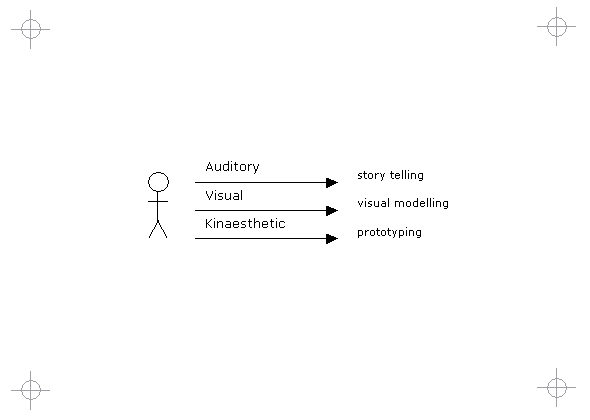|
Diagram
|
|
|

|
|
Title
|
|
|
Learning Methods
|
|
Building Architecture
|
|
|
There is evidence of how learning methods apply in building architecture - the Greeks as tactile thinkers, perspective in Roman architecture, the visual language pursued by modernists, the story telling in cultures pursuing natural architecture.
For visual thinkers, geometric shapes and forms can be used in abstract thinking and modeling - the practice of using a grid to aid in visualising perspectives, in spreadsheet like analysis of logical artifacts and the use of eclipses in process models are some examples. The tactile space intuitions and its correlation to prototyping helps us appreciate why for some understanding a problem begins in the construction process.
|
|
Architecture Intensive Disciplines
|
|
|
When considering which analysis and design technique to adopt, consider the learning method of individuals. Auditory learners in your team will benefit from story telling, visual learners will prefer diagrams and kinaesthetic learners will prefer to prototype.
It is no coincidence that spreadsheets are popular productivity tools. The use of grids and boxes to help in abstracting ideas - lists, cross-referencing, hierarchical classifications, etc - is also noted in Michael Michalko's "Thinker Toys", a book on creative thinking. It is important in architecture intensive disciplines to develop both visual and tactile perception. It is not enough to understand specific notations such as the Unified Modeling Language. Architects must also understand how mental models are formed from visual shapes and forms as well as through crafting, prototyping and interaction.
|
|
Case Study A: Large Corporate IT
|
|
|

|
|
|
Some developers responded well to visual models, others did not. It became clear when observing the way developers analyse and design, that individual learning methods were relevant to selecting the right approach. This pattern was discussed with members of the team before mentoring the UML so that alternative approaches could be considered such as prototyping. Some members of the team were better suited to pair programming and prototyping. In hindsight, the correct application of Extreme Programming may have been ideal for some who were not keen on visual models - i.e. UML.
|
|
Case Study B: Small Commercial Team
|
|
|

|
|
|
The pattern of learning methods was relevant but we did not tailor or observe this pattern. With such a small team, the interaction and communication was fairly dynamic enough so that individual learning took place naturely. No problems were observed or expressed with whatever approach was used - documentation, story telling or models.
|
|
|


